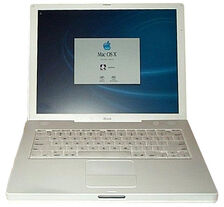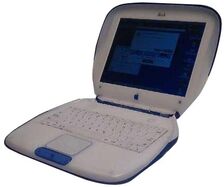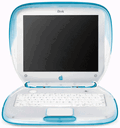
iBook G3 (900 Mhz, early 2003)
The iBook is a laptop version of an iMac computer manufactured by Apple Computer and targeted at the consumer and education market segments. It was present from 1999 to 2006.
The first model was released on July 21, 1999. All iBook models contained a PowerPC 750 ("G3") CPU, until the iBook G4 was released on October 23, 2003.
First-generation iBooks[]

Indigo iBook G3 (266 Mhz, Sept. 2000)
- Main article: iBook (first generation)
The first-generation ("clamshell") iBook acquired a reputation for ruggedness and durability. It was designed with the college student in mind. The case was made of a soft, rubberized plastic and featured a built-in carrying handle for ease in carrying around campus without a complicated notebook case. The clamshell didn't have a lock or latch (which are known for being susceptible to damage in some notebook computers), and instead "snapped" shut. Like most Macs, the iBook would enter sleep mode when closed, saving the state it was in before entering sleep; This made it ideal for the student who was running between classes with limited time, as they did not have to wait for a shut-down or "hibernate" sequence in in other operating systems.
iBook Special Edition[]
- Main article: iBook Special Edition
iBook (FireWire)[]
- Main article: iBook (FireWire)
iBook (Dual USB)[]

Ports on the iBook G3 (early 2003) from left to right: Kensington security slot, 56k modem port, Ethernet port, FireWire port, 2 USB 1.1 ports, video out port, audio headphone jack
- Main article: iBook (Dual USB)
The second generation (rectangular and made of hard plastic), released on May 1, 2001, was considered by some to be more stylish, and featured two-toned white and silver plastic and a clear external shell. Later versions replaced the transparent-and-white outer shell with solid white plastic.
iBook G4[]
- Main article: iBook G4
Display problems[]
In late November 2003, a number of iBook users started to report a display problem with their laptops [1]. At one point, a group of users [2] even sought to file a class action suit against Apple. In response to the problem, in January 2004, Apple initiated the "iBook Logic Board Repair Extension Program" [3], which covers any expense of repairing "affected iBooks for three years" -- essentially an extended warranty for the affected products. According to users reporting problems and Apple, products manufactured during May and April 2003 have problems with their main logic board. The reported symptoms include scrambled, flickering or distorted display.
Models[]

Blueberry iBook
- July 21, 1999 - iBook (300 MHz processor / 32 MB RAM / 3.2 GB HD) available in Blueberry (light blue) and Tangerine (orange)
- February 16, 2000
- iBook (revision B) (64 MB RAM / 6 GB HD)
- iBook Special Edition (366 MHz processor / 64 MB RAM / 6 GB HD) available in Graphite (gray)
- September 13, 2000
- iBook (FireWire) (366 MHz processor / 64 MB RAM / 10 GB HD) available in Indigo (dark blue) and Key Lime (green), included a FireWire port and video out.
- iBook (FireWire) Special Edition (466 MHz processor) available in Key Lime (green) and Graphite (grey). Also included a DVD-ROM drive.

iBook G3 (500 MHz)
- May 1, 2001 - iBook (Dual USB) (500 MHz processor / 64 MB RAM / 10 GB HD) available in only white, increased screen resolution to 1024x768, added an additional USB port. Offered a choice of optical drives (CD-ROM, CD-RW, DVD/CD-RW).
- October 16, 2001 - iBook (Late 2001) (600 MHz processor / 128 MB RAM 15-20 GB HD) increased bus speed to 100MHz.
- May 20, 2002 - iBook (May 2002) (700 MHz processor / 20-30 GB HD) added ATI Radeon Mobility in both 12" and 14" models.
- November 5, 2002 - iBook (November 2002) (800 MHz processor) now priced $200 less than previous models, "good" configuration starting at $999.
- April 22, 2003 - iBook (Early 2003) (900 MHz processor / 40 GB HD/ 256MB of RAM) was a processor upgrade aimed at the high end 14 inch iBook.
- October 23, 2003 - iBook G4 launched, marking the retirement of the PowerPC G3 processor across all of the Apple range, and hence Mac OS 9 is no longer bootable on any shipping machine, except for the legacy Power Macintosh G4 computers Apple continues to sell (as of April 2004). The new iBook featured a G4 with 256 KB L2 cache (half that of the PowerBooks of the same era) running on a 133 MHz bus at 800 MHz on the 12" iBook as well as the lower 14" model, and 1 GHz on the upper 14" model, almost all fitted with slot-load "combo" drives. Additionally, slight cosmetic changes were included with the new G4 models, including a replacement of the translucent keyboard (seen on the previous G3 versions) with new, opaque keys. Prices started at $1099.
- April 19, 2004 - Second revision of the iBook G4 announced, resulting in Apple reaching the 1 GHz mark all across the line. The iBook now featured the same processor as the PowerBook, although running on a slower bus. This new revision featured double the L2 cache of the original iBook G4 released in October 2003. The bottom-line 12" iBook as well as the lower 14" model ran at 1 GHz and the upper 14" model ran at 1.2 GHz. The RAM ceiling doubled to 1280 MB, and for the first time the 14" iBooks were available with a SuperDrive -- Apple's CD-RW/DVD-RW drive -- as an option. AirPort Extreme was standard on the high-end 14" model. Prices started at $1099 for the 12" model, and $1299 for the 14" model.
- October 19, 2004 - Third revision of the iBook G4 announced. The 12" model has been upgraded to a 1.2 GHz processor, and the two 14" models run at 1.33 GHz. All iBooks now come standard with AirPort Extreme. Prices range from $999, a $100 drop for the 12" model, to $1499 for the SuperDrive-equipped 14" model.
References[]
See also[]
External links[]
- iBook at Apple (archived 1999-10-01)
- iBook-User the first web site for the iBook (archived 2017-09-12)
- Linux Laptop & Notebook Installation Guides: Apple (aka Macintosh) at TuxMobil (archived 2015-10-31)
- Steve Jobs introduces the iBook by CNN at GeoCities (archived 2002-10-05, QuickTime 7 required)
- iBook at the Hardware Wiki
- iBook at Wikipedia
